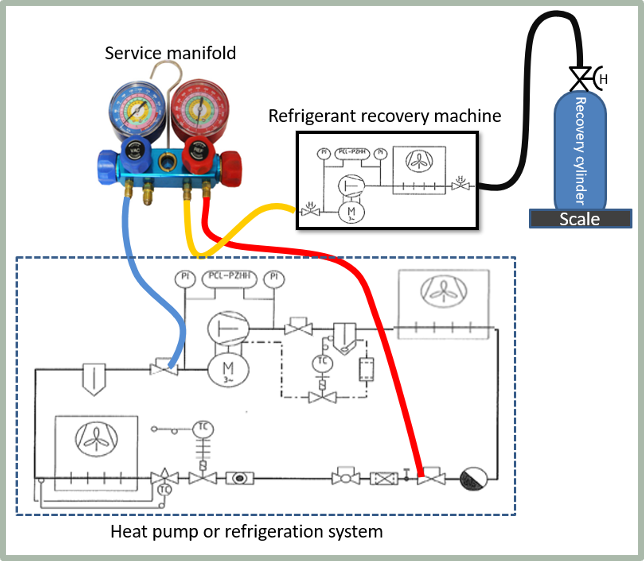9. General Lifecycle of HFOs
This section provides a short overview of the different stages in the life cycle of HFOs. Since none of the Nordic countries manufacture HFOs, the national lifecycles begins with the import of HFO substances. The general lifecycle of HFOs does not differ from the general lifecycle of HFCs.
The specific infrastructure across the Nordic countries will be further elaborated in the later sections.
9.1 Import
Refrigerants are imported in bulk in gas cylinders to fill, refill and maintain equipment, or they are imported concealed in products. Refrigerants can also re-enter the market after reclamation.
9.2 Use
The gases are typically used as a working fluid in products or equipment. In some appliances, refrigerants may leak during the use phase. For instance, a vehicle’s AC gradually and continuously leaks refrigerants from the system and must be re-filled every few years. Other equipment, such as domestic AC equipment, only needs to be refilled if there is a breach in the system.
In case there is a breach in installed equipment or a product, the general procedure for the qualified technician is to recover the refrigerant from the system by transferring the refrigerant to a gas container, repairing the leakage, and then refilling the system, either with the recovered refrigerant after a basic cleaning process or with new virgin refrigerant of the same type. However, some blends can be drop-ins for other previously used refrigerants.
Copenhagen School of Marine Engineering and Technology Management (2023)
The lifetime of gas-containing products varies. Building and construction foams typically have lifetimes spanning decades, meaning that there are still vast amounts of refrigerants from previous generations in circulation.
9.3 Recovery
At end-of-life, the product or equipment is decommissioned. For smaller products, refrigerants are often recovered at a centralised facility after collection. On-site installations are emptied on-site, often by RAC companies. Recovered gases are then either recycled, reclaimed, or destroyed.

Figure 4 Illustration of refrigerant recovery from a Heat pump or refrigeration system from 'Køleanlæg og Varmepumper - Grundbog om køleteknik' (Refrigeration systems and heat pumps Basic book on refrigeration technology) by Peter Hørning, 2022
9.4 End-of-life Treatment
Export/Import of waste
Some countries do not have the facilities to handle end-of-life treatments of refrigerants, but export refrigerants in bulk or products for destruction, recycling or reclamation in other countries after recovery and collection. Transboundary waste transfer requires permission under the Waste Shipment Regulation
Regulation (EC) No 1013/2006
Recycling
Recycling refers to a process where the refrigerant goes through a basic cleaning process before it is reused. Recycling is often done on-site, where the technician performs a basic refrigerant cleaning during maintenance to remove water, oil, and particles from the substance. The recycling process can also be done commercially at a treatment facility. The recycling process requires that the refrigerant is free of cross-contamination.
Reclamation
Reclamation means that the refrigerant is reprocessed by a licensed facility, where it is analysed, purified, certificated, guaranteed, and then returned to the market. The reclaimed refrigerant will have a performance equivalent to a virgin refrigerant and must meet a specified performance standard such as AHRI-700. A chemical analysis is required to ensure that the specifications are met.
RTOC (2022b)
Destruction
In the final stage of the lifecycle, the refrigerant is neutralised by destruction. The destruction of refrigerants takes place at a licensed destruction facility. Several different destruction practices are approved for fluorinated refrigerants. They are usually destroyed using thermal oxidation (incineration) or high-temperature plasma arc technology.